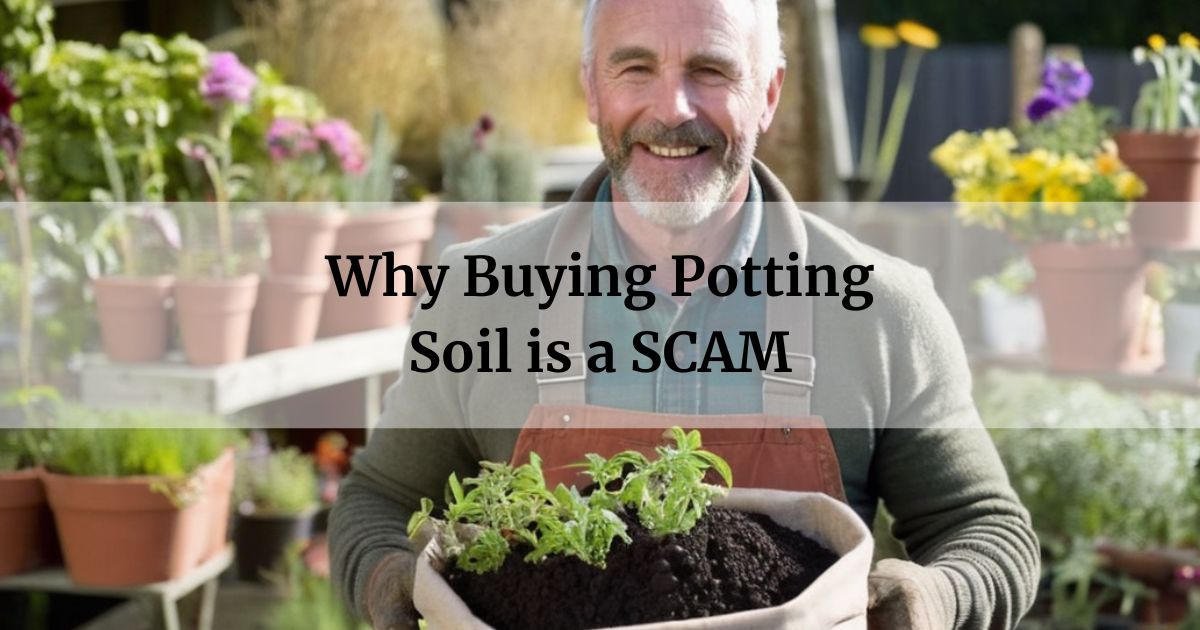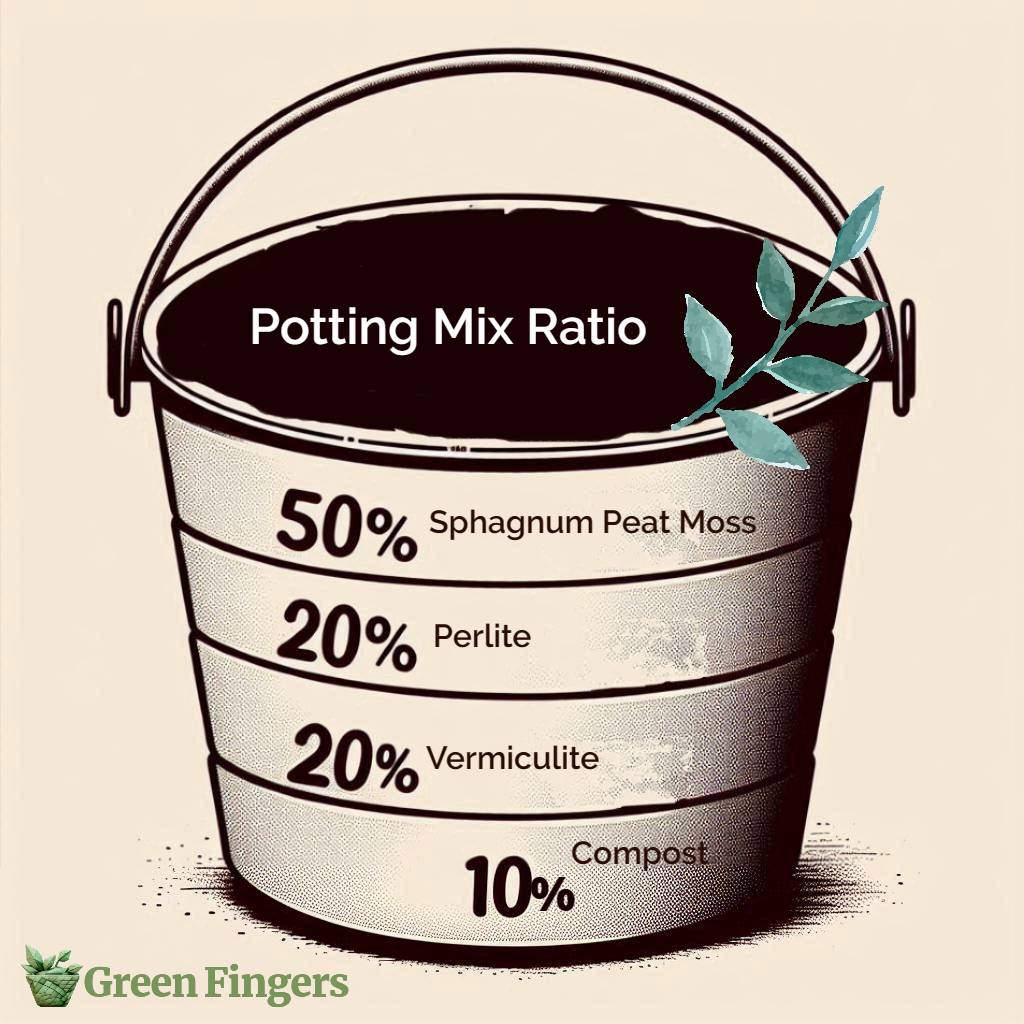
Gardening can be expensive when you fall for marketing tricks that sell you the same exact potting soil mix in multiple bags but labelled for different uses. This guide will provide you with the knowledge and tools to take control of your gardening needs and save your hard-earned money.
In this article
Why store-bought potting soil is a scam
Potting mixes are typically composed of a few key ingredients: sphagnum peat moss, perlite, vermiculite, and sometimes fertilizer. These components work together to create a soilless, well-draining medium that provides the ideal growing environment for a variety of plants.
The problem arises when these basic potting mix ingredients are repackaged and marketed as specialized products, such as orchid mix, African violet mix, seed starting mix, and cactus blend. In reality, these “specialized” mixes are often just the original potting mix, with little to no additional modifications.
The real kicker is the significant price difference between the generic potting mix and the specialized versions. Consumers can end up paying significantly more for the same basic product, simply because it’s been rebranded and marketed for a specific use.
The truth is, with some simple tweaks you can turn one bag of generic potting mix into multiple custom blends tailored for specific plant groups. All it takes is a basic sieve to sift the mix into different textures.
Basic Potting Mix

To create a well-balanced and effective potting mix, you’ll need a combination of four basic ingredients:
- Sphagnum Peat Moss (40-50%): Provides a neutral pH, retains moisture, and improves soil structure.
- Perlite (20-30%): Enhances drainage, aeration, and prevents soil compaction.
- Vermiculite (10-20%): Improves water-holding capacity, enhances soil structure, and provides aeration.
- Compost (10-20%): Adds nutrients, organic matter, and improves soil structure.
Optional Ingredients
- Sand (0-10%): Improves drainage for plants that don’t like wet soil.
- Limestone (Dolomitic Lime) (0-5%): Neutralizes acidity and provides essential nutrients.
- Slow-Release Fertilizer (0-5%): Provides a steady supply of nutrients over time.
Ratios
- Basic Mix: 40% sphagnum peat moss, 20% perlite, 20% vermiculite, and 10% compost.
- Customized Mix: Adjust the ratios based on your specific plant needs and preferences.
Tips
- Start with a basic mix: Use the basic mix as a starting point and adjust as needed based on your plant’s requirements.
- Experiment and adjust: Don’t be afraid to try different ratios and ingredients to find the perfect mix for your plants.
- Use high-quality ingredients: Choose reputable sources for your ingredients to ensure the best results.
- Store your mix properly: Keep your homemade potting mix in an airtight container to maintain its quality and prevent contamination.
Sifting for Customization
The good news is you can easily create your own specialized mixes at a fraction of the cost.
The key to creating your own specialized mixes lies in sifting the potting mix using a quarter-inch mesh sieve. This simple process separates the mix into finer and coarser textures, allowing you to tailor the medium to the specific needs of your plants. For example, orchids thrive in a coarser, well-draining medium, while African violets prefer a soilless mix to prevent root rot. By sifting the potting mix, you can easily create these specialized mixes at a fraction of the cost of the pre-packaged versions.
Enhancing the Mixes
To further customize your soil mixes, you can add additional ingredients, such as sand, to the sifted potting mix. This allows you to create specialized blends, like a cactus mix, that cater to the specific needs of your plants.
| Ingredient | Benefits/Uses |
|---|---|
| Sand | – Improves drainage for plants that don’t like wet soil, such as cacti, succulents, and citrus – Helps create a coarser texture for plants that prefer a well-draining medium, like orchids |
| Perlite | – Increases aeration and drainage – Helps prevent soil compaction – Useful for seed starting and propagation |
| Vermiculite | – Improves water-holding capacity – Enhances soil structure and aeration – Beneficial for seedlings and young plants that need consistent moisture |
| Compost | – Adds nutrients and organic matter to the soil – Improves soil structure and water-holding capacity – Can be used to create a more nutrient-rich potting mix |
| Coir (Coconut Fiber) | – Provides a sustainable alternative to peat moss – Helps retain moisture while still allowing for good drainage – Useful for plants that prefer a slightly acidic soil |
| Limestone (Dolomitic Lime) | – Helps neutralize the acidity of peat moss-based mixes – Provides calcium and magnesium, essential nutrients for plant growth |
| Slow-Release Fertilizer | – Provides a steady supply of nutrients over time – Helps ensure your plants have the necessary nutrients for healthy growth |
Here’s how to make your own custom blends:
Create an Orchid Mix
Orchids prefer a coarser mix that drains well and doesn’t retain too much moisture. Sifting your potting mix removes fine particles, creating the perfect airy texture for orchid roots. No need to spend extra on “orchid mix”!
African Violet Soil
African violets thrive in a well-draining, soilless medium to prevent root rot. Again, simple sifting provides the same lightweight blend as expensive “African violet mix”.
Seed Starting Soil
Seed starting soil needs good moisture retention. Leaving some fine particles in your sifted mix mimics store-bought “seed starting mixes”.
Cactus and Succulent Soil
Add coarse sand to sifted potting mix for improved drainage loved by cacti, succulents and other plants that hate wet feet. Now you’ve got “cactus blend” for less!
Raised Bed Mix
Save even more by knowing that “raised bed mix” is no different than standard potting soil. Avoid meaningless label tricks and enjoy gardening without overthinking products. With some simple DIY soil blending, you’ll nurture beautiful, healthy plants while saving your wallet plenty of space to grow.
Save Money and Simplify Gardening
The key takeaway is that you don’t need to fall victim to marketing scams that sell the same product under different names for different uses. By understanding the basic composition of potting mixes and taking the time to sift and customize them, you can save a significant amount of money while enjoying the benefits of tailored soil mixes for your plants. Gardening should be a rewarding and enjoyable experience, not an overwhelming one.
Please let me know if you have tried mixing your own potting soil and how it worked for you?
YOU MAY ALSO LIKE: When You Should Fertilize Your Indoor Herb Garden [And How Often]







